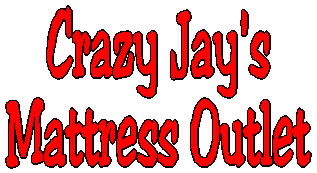Mattress Buyer's Guide - Pitfalls in Shopping for a Mattress
There are many different brands, models, features, prices, etc., that can make shopping for a new mattress set somewhat confusing. It is also important to note that most mattresses are sold simply by merchandising gimmicks. A few of the more common “pitfalls” of mattress shopping are outlined below.
Puffery
It is important to note that many mattresses and box springs are sold by using merchandising gimmicks.
Mattress salespeople may mislead or exaggerate claims about products just to close a sale. Puffery, or exaggerating the benefits
of a product, is common in advertising and selling. Anyone can say their product is better than someone else's. You should
ask the salesperson to explain and prove their position with facts. Ask to see what is inside the product so you can decide
for yourself. Puffery is another reason why it is extremely important to do your homework, talk to your family and friends
about their experiences and ultimately buy from a store you can trust.
Comparison Shopping
If you are a shopper who likes to compare values from store to store, you should be aware
that comparison shopping by model name can lead to frustration. The manufacturer, who relies on retail stores to sell its
products, makes minor modifications to their mattresses for each mattress retailer. The manufacturer will put a different
cover on the mattress and change the name so that it will be difficult to compare from one retailer to another. This will
result in very similar mattresses being sold by different retailers under different names most likely at different prices.
So, find a sleep set you like, then see what level of comfort, support, and quality components you can get for the same amount
of money in another store.
“No-Flip” / One-Sided Mattresses
The important question to ask here is whether or not this is really
a benefit to you, the consumer. In our opinion, the manufacturer and retailer have everything to gain here by reducing their
costs, but the consumer is short changed. From what we have seen, we simply do not believe that the customer has anything
to gain from a one-sided product. We like to call “no-flip” mattresses “can’t flip” mattresses.
The implication of the “no- flip” products is that they don’t need to be flipped. In fact, these products
are designed with padding on only one side and cannot be flipped. Although you do not have to flip a 2 sided mattress, flipping
can extend the life of your product and minimize body impressions.
Features, But Are They Benefits?
Manufacturers add features such as edge supports, wool, silk, and cashmere fiber
in the upholstery or a thin layer of memory foam under several other upholstery layers that you can't even feel. These features
increase the price of the product, sometimes by a substantial amount. The question is, do these features provide benefit or
are they merely bells and whistles? Consumers must decide if the modifications are beneficial. For more information on these
topics, please visit the “Special Features” section of this guide.
The Word “Firm”
Manufacturers describe almost all mattresses as some variation of “firm”.
It’s a carry-over from the days when people thought mattresses had to be hard as a board to be good for you. Even though
the trend has been toward softer mattresses, you’ll still encounter descriptions such as firm, extra firm, gentle firm,
super firm, etc. Descriptions are not consistent, so one manufacturer’s “firm” may be another’s “extra
firm”. Try the mattress and decide for yourself what is comfortable to you.
Low Price Ads
It is a common practice to advertise a low starting price mattress set. But when customers want
to see this mattress set, some retailers will try to persuade them to a higher priced mattress. You may also find that low
price ads are simply used to bring you in to a particular store. In many cases, the product represented in these ads is difficult,
if not impossible, to get.
Big Sale Ads
Those big sales that happen only once a year and advertise 50% off or more are usually not sales
at all, but are created to meet the consumer’s desire for a “deal”. Only the imagination can limit the reason
for the so called sale. For example, President’s Day, Anniversary, New Store Opening, Inventory Clearance, Lost their
Lease, 4th of July, etc. The old adage “buyer beware” comes to mind here. If a store can sell for less on certain
days, why not all the time?
- On all ads, you would be well advised to read the fine print.


